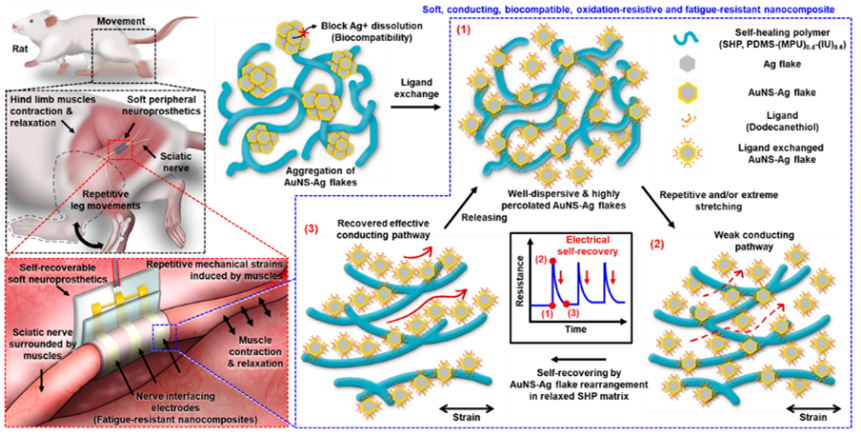The Neural Interfaces Team aims to carry out multidisciplinary research where soft, stretchable, and tissue-adhesive materials and devices are applied to neural tissue-interfacing bioelectronics capable of seamlessly mounting onto brain. Such materials strategies and device fabrication processes are highly beneficial for either precisely making a diagnosis of neurological diseases (e.g., epilepsy, Parkinson’s diseases) or effectively delivering feedback therapy. In this regard, the pathological mechanism of the diseases can be studied.
(1) Neuroadhesive Biomaterials (PI: Mikyung Shin)

The neuroadhesive, stretchable, and conductive polymeric biomaterials are promising for long-term stable signal recording from bioelectronics implanted on brain tissue. We modify versatle synthetic/natural polymers with sticky chemical moieties inspired by nature adhesion phenomena, and design biomedial formulations, such as hydrogels and thin film, combined with biocompatible conductive polymers. Such biomedical formulations are useful for mechanical modulus matching to biological tissues. Based on engieered biomaterials, we are also focusing on integration of hydrogel interfaces with electronic device for efficeint therapy in both central/peripheral nervous system.
(2) Implantable Bioelectronics for Neural Interfacing (PI: Donghee Son)

A durable and fatigue-resistant soft neuroprosthetic device with bidirectional signaling on peripheral nerves is made of a nanocomposite of gold nanoshell (AuNS)-coated silver (Ag) flakes dispersed in a tough, stretchable, and self-healing polymer (SHP). The dynamic self-healing property of the nanocomposite allows the percolation network of AuNS-coated flakes to rebuild after degradation. Therefore, its degraded electrical and mechanical performance by repetitive, irregular, and intense deformations at the device–nerve interface can be spontaneously self-recovered. When the device is implanted on a rat sciatic nerve, stable bidirectional signaling is obtained for over 5 weeks. Neural signals collected from a live walking rat using these neuroprosthetics are analyzed by a deep neural network to predict the joint position precisely.
SELECTED PUBLICATIONS
1. A vacuum-deposited polymer dielectric for wafer-scale stretchable electronics, Koo J. H. et al. (2023), Nat Electron, In press
2. Molecular rationale for the design of instantaneous, strain-tolerant polymeric adhesive in a stretchable underwater human–machine interface, Choi Y. et al. (2022), ACS Nano, 16, 1368
3. Stretchable colour-sensitive quantum dot nanocomposites for shape-tunable multiplexed phototransistor arrays, Song J.-K. et al. (2022), Nat Nanotechnol, 17, 849
4. Electrostatic-mechanical synergistic in situ multiscale tissue adhesion for sustainable residue-free bioelectronics interface, Kim D.W. et al. (2022), Adv Mater, 34, 2105338
5. Durable and fatigue-resistant soft peripheral neuroprosthetics for in vivo bi-directional signaling, Seo H. et al. (2021), Adv Mater, 33, 2007346

